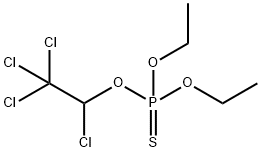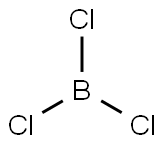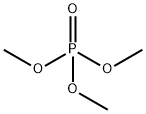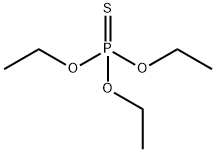CHLORETHOXYFOS
- CAS NO.:54593-83-8
- Empirical Formula: C6H11Cl4O3PS
- Molecular Weight: 336
- MDL number: MFCD01704894
- SAFETY DATA SHEET (SDS)
- Update Date: 2023-05-04 17:34:39

What is CHLORETHOXYFOS?
Chemical properties
Gray to reddish-brown granular solid or colorless liquid. Mild sulfur-like odor.
Chemical properties
Chlorethoxyfos is a colorless liquid. Technical chlorethoxyfos is a light-to- dark brown liquid. Stable at room temperature for >18 months; stable at 55°C for 2 weeks. Chlorethoxyfos is characterized as having a “strong” odor.
The Uses of CHLORETHOXYFOS
Chlorethoxyfos is a soil-applied organophosphorus insecticide used to control various soil insects (e.g. corn rootworms) in maize.
The Uses of CHLORETHOXYFOS
Insecticide.
The Uses of CHLORETHOXYFOS
Chlorethoxyfos is an organophosphorous pesticide/insecticide.
Definition
ChEBI: Chlorethoxyfos is an organic thiophosphate, an organothiophosphate insecticide and an organochlorine insecticide. It has a role as an agrochemical and an EC 3.1.1.7 (acetylcholinesterase) inhibitor.
Agricultural Uses
Insecticide: Chlorethoxyfos is a restricted use organophosphate insecticide registered for use in the U.S. on field corn, seed corn, sweet corn, and popcorn for the control of corn rootworms, wireworms, cutworms, seed corn maggots, white grubs, and symphylans. A U.S. EPA restricted Use Pesticide (RUP). Not listed for use in EU countries.
Trade name
DPX-43898®; FORTRESS 2.5G; FORTRESS® 5G; SD 208304®
Potential Exposure
An organophosphate insecticide, chlorethoxyfos is a restricted use organophosphate insecticide registered for use in the United States on field corn, seed corn, sweet corn, and popcorn for the control of corn rootworms, wireworms, cutworms, seed corn maggots, white grubs, and symphylans. A United States Environmental Protection Agency Restricted Use Pesticide (RUP). Not currently listed for use in EU countries.
Carcinogenicity
According to an EPA summary, an 18 month study in which mice were given diets with chlorethoxyphos (doses not provided) was negative for carcinogenicity . A 2 year rat feeding (doses not provided) study showed a slight, nonsignificant increase in kidney tumors, and EPA concluded “the study was adequate for carcinogenicity testing” but that it was difficult to clearly interpret the data as showing either the presence or the absence of a carcinogenic effect .
Metabolic pathway
Chlorethoxyfos undergoes extensive degradation and metabolism in water, soil, plants and animals. Cleavage of the P-O-tetrachloroethyl bond is the major degradation reaction of chlorethoxyfos. Dechlorination and oxidation of the tetrachloroethyl moiety yielded chloral, dichloroacetic acid and trichloroacetic acid as major degradation products. The extensive metabolism of chlorethoxyfos and its degradation products yielded 14CO2 and amino acids (glycine, serine, etc.). Oxidative desulfuration to yield chlorethoxyfos-oxon or O-de-ethylation reactions were not observed.
Shipping
UN2783 Organophosphorus pesticides, solid, toxic, Hazard Class: 6.1; Labels: 6.1-Poisonous materials. UN3018 Organophosphorus pesticides, liquid, toxic, Hazard Class: 6.1; Labels: 6.1-Poisonous materials.
Degradation
Chlorethoxyfos is susceptible to alkaline hydrolysis. The DT50 values of
chlorethoxyfos in buffers at pH 5, 7 and 9 at 25 °C were 72, 59 and 4.3
days, respectively (Hawhs et al., 1988a). The primary hydrolytic
degradation reaction was the cleavage of the P-O-tetrachloroethyl bond.
The major [14C-tetrachloroethyl]chlorethoxyfos degradation product observed
in pH 5 and 7 aqueous solutions was chloral (trichloroacetaldehyde,
2), formed probably via the tetrachloroethanol (3) intermediate. In
alkaline solution (pH 9), the principal product was dichloroacetic acid (4),
formed probably via the dehydrochlorinated intermediate (5).
Chlorethoxyfos degraded slowly in aqueous solution when exposed
to UV light at 25 °C [DT50 ca. 27 days (continuous irradiation) vs. 19
days (dark control)] (Hawkins et al., 1988b). Cleavage of the P-O-
tetrachloroethoxy bond yielded chloral (2) as the primary aqueous
photolysis product.
Incompatibilities
May react violently with antimony(V) pentafluoride. Incompatible with lead diacetate, magnesium, silver nitrate. In the presence of strong reducing agents such as hydrides, organophosphates form highly toxic and flammable phosphine gas. Contact with oxidizers can cause the release of toxic oxides of phosphorus.
Waste Disposal
Destruction by alkali hydrolysis or incineration. May also be mixed with flammable solvent and sprayed into an incinerator equipped with after burner and scrubber. Containers must be disposed of properly by following package label directions or by contacting your local or federal environmental control agency, or by contacting your regional EPA office. Afterburner
Properties of CHLORETHOXYFOS
| Boiling point: | bp0.05 torr 80° |
| Density | d420 1.464 |
| vapor pressure | 0.11 Pa (25 °C) |
| refractive index | nD25 1.4980 |
| Flash point: | 128℃ |
| storage temp. | 2-8°C |
| solubility | Chloroform (Slightly), Methanol (Slightly) |
| form | Oil |
| Water Solubility | 2.1 mg l-1 (25 °C) |
| color | Colourless |
| EPA Substance Registry System | Chlorethoxyfos (54593-83-8) |
Safety information for CHLORETHOXYFOS
| Signal word | Danger |
| Pictogram(s) |
 Skull and Crossbones Acute Toxicity GHS06  Environment GHS09 |
| GHS Hazard Statements |
H300:Acute toxicity,oral H310:Acute toxicity,dermal H319:Serious eye damage/eye irritation H330:Acute toxicity,inhalation H410:Hazardous to the aquatic environment, long-term hazard |
| Precautionary Statement Codes |
P260:Do not breathe dust/fume/gas/mist/vapours/spray. P264:Wash hands thoroughly after handling. P264:Wash skin thouroughly after handling. P273:Avoid release to the environment. P280:Wear protective gloves/protective clothing/eye protection/face protection. P284:Wear respiratory protection. P301+P310:IF SWALLOWED: Immediately call a POISON CENTER or doctor/physician. |
Computed Descriptors for CHLORETHOXYFOS
New Products
4-Aminotetrahydropyran-4-carbonitrile Hydrochloride (R)-3-Aminobutanenitrile Hydrochloride 4-AMINO-TETRAHYDRO-PYRAN-4-CARBOXYLIC ACID HCL 4-(Dimethylamino)tetrahydro-2H-pyran-4-carbonitrile 3-((Dimethylamino)methyl)-5-methylhexan-2-one oxalate 1,4-Dioxa-8-azaspiro[4.5]decane 5-Bromo-2-nitropyridine Nimesulide BP Aceclofenac IP/BP/EP Diclofenac Sodium IP/BP/EP/USP Mefenamic Acid IP/BP/EP/USP Ornidazole IP Diclofenac Potassium SODIUM AAS SOLUTION ZINC AAS SOLUTION BUFFER SOLUTION PH 10.0(BORATE) GOOCH CRUCIBLE SINTERED AQUANIL 5 BERYLLIUM AAS SOLUTION 2-Bromo-1-(bromomethyl)-3-chloro-5-nitrobenzene 2-Bromo-3-nitroaniline N-(3-Hydroxypropyl)-N-methylacetamide 3-Bromo-6-chloropyridazine 4-ethyl-3-nitrobenzoic acidRelated products of tetrahydrofuran








You may like
-
 1-Methyl-6-oxo-1,6-dihydropyridazine-3-carbonitrile 98%View Details
1-Methyl-6-oxo-1,6-dihydropyridazine-3-carbonitrile 98%View Details
99903-60-3 -
 88491-46-7 98%View Details
88491-46-7 98%View Details
88491-46-7 -
 1823368-42-8 98%View Details
1823368-42-8 98%View Details
1823368-42-8 -
 2-(3-(tert-butyl)phenoxy)-2-methylpropanoic acid 1307449-08-6 98%View Details
2-(3-(tert-butyl)phenoxy)-2-methylpropanoic acid 1307449-08-6 98%View Details
1307449-08-6 -
 Ethyl 3-(furan-2-yl)-3-hydroxypropanoate 25408-95-1 98%View Details
Ethyl 3-(furan-2-yl)-3-hydroxypropanoate 25408-95-1 98%View Details
25408-95-1 -
 2-Chloro-5-fluoro-1-methoxy-3-methylbenzene 98%View Details
2-Chloro-5-fluoro-1-methoxy-3-methylbenzene 98%View Details
1805639-70-6 -
 1784294-80-9 98%View Details
1784294-80-9 98%View Details
1784294-80-9 -
 Lithium ClavulanateView Details
Lithium ClavulanateView Details
61177-44-4